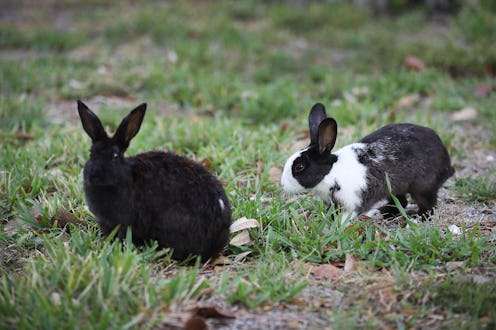
We've seen him at malls across America, posing with children anxious for candy, but have you ever questioned why this giant, friendly bunny has become the ultimate spokesperson for Easter? The history of the Easter Bunny is pretty intriguing, and like many holiday figures, has evolved quite a bit over time.
Also, just like many holiday figures, the exact origins of the Easter Bunny are a bit mysterious. However, it's been popularly believed that Easter is represented by a bunny for a couple reasons — one, because Easter started as a pagan holiday, and the Germanic goddess Eostre was fond of hares. Rabbits in general are also pretty well known for repopulating rather quickly (especially in the spring), and as Eostre represented fertility, a rabbit was a proper symbol.
Easter in general is about the celebration of new life. Christians, especially, believe in this, as Easter is the holiday celebrating the resurrection of Jesus Christ from the dead. Some actually believe that the rabbit symbolizes Jesus himself. I mean, what better way to celebrate renewal than with a rabbit?
The Easter Bunny didn't get his start that easily, though. At first, the concept was developed by German Protestants, who envisioned the Easter Bunny to function somewhat like Santa Claus. While he didn't have a list that he checked twice, the Easter Bunny definitely judged children and awarded an Easter egg hunt for only children who had been good. This version was called the "Easter Hare," and was present in the late 1600s.
No matter what, eggs were always involved with the Easter Bunny's ensemble — typically, he had a basket with him at all times, thus differentiating himself from other giant bunnies. Eggs were definitely a symbol of new beginnings and purity, and receiving them as a gift was a joy. The coloring of the eggs also developed over time. It's believed that the tradition, in general, came from the Pennsylvania Dutch in the 1700s. They believed in the “Osterhase,” which was an egg-laying hare, and encouraged children to build nests for the Osterhase to lay in and produce his colorful eggs. Today, instead of nests, we use baskets to keep this tradition alive. And of course, we leave a carrot out for the Easter Bunny to munch on, to say thank you for the delicious eggs and candies, and sometimes giftcards, he leaves behind.
Know what other animal incorporates the renewal of spring? Birds. A 1990 story by Sarah Ban Breathnach gave the Easter Bunny a slightly different origin story — supposedly he was once a large bird, turned into a hare by Eostre when she was ticked off. While it's a theory, it's definitely in the category of the Easter Bunny himself — folklore. (Although honestly, I don't see how being turned into a beloved, fuzzy animal could truly be punishment. If she turned the bird into a housefly, or an ant, that's a completely different story.)
Next time you see your local Easter Bunny at the mall, or perhaps in your Easter basket in chocolate form, remember how much he has grown throughout the years. And be thankful that he's not as judgmental as he used to be, since everyone deserves a little chocolate every once in awhile.
Images: Joe Raedle/Getty Images; Giphy (2)